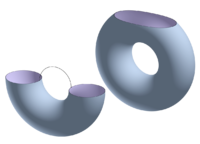
Photo from wikipedia
It is known that connected translation invariant n-dimensional noncommutative differentials dxi on the algebra k[x1, …, xn] of polynomials in n-variables over a field k are classified by commutative algebras… Click to show full abstract
It is known that connected translation invariant n-dimensional noncommutative differentials dxi on the algebra k[x1, …, xn] of polynomials in n-variables over a field k are classified by commutative algebras V on the vector space spanned by the coordinates. These data also apply to construct differentials on the Heisenberg algebra “spacetime” with relations [xμ, xν] = λΘμν, where Θ is an antisymmetric matrix, as well as to Lie algebras with pre-Lie algebra structures. We specialise the general theory to the field k=F2 of two elements, in which case translation invariant metrics (i.e., with constant coefficients) are equivalent to making V a Frobenius algebra. We classify all of these and their quantum Levi-Civita bimodule connections for n = 2, 3, with partial results for n = 4. For n = 2, we find 3 inequivalent differential structures admitting 1, 2, and 3 invariant metrics, respectively. For n = 3, we find 6 differential structures admitting 0, 1, 2, 3, 4, 7 invariant metrics, respectively. We give some examples for n = 4 and general n. Surprisingly, not all our geometries for n ≥ 2 have zero quantum Riemann curvature. Quantum gravity is normally seen as a weighted “sum” over all possible metrics but our results are a step towards a deeper approach in which we must also “sum” over differential structures. Over F2 we construct some of our algebras and associated structures by digital gates, opening up the possibility of “digital geometry.”It is known that connected translation invariant n-dimensional noncommutative differentials dxi on the algebra k[x1, …, xn] of polynomials in n-variables over a field k are classified by commutative algebras V on the vector space spanned by the coordinates. These data also apply to construct differentials on the Heisenberg algebra “spacetime” with relations [xμ, xν] = λΘμν, where Θ is an antisymmetric matrix, as well as to Lie algebras with pre-Lie algebra structures. We specialise the general theory to the field k=F2 of two elements, in which case translation invariant metrics (i.e., with constant coefficients) are equivalent to making V a Frobenius algebra. We classify all of these and their quantum Levi-Civita bimodule connections for n = 2, 3, with partial results for n = 4. For n = 2, we find 3 inequivalent differential structures admitting 1, 2, and 3 invariant metrics, respectively. For n = 3, we find 6 differential structures admitting 0, 1, 2, 3, 4, 7 invariant metrics, respectively. We give some...
Journal Title: Journal of Mathematical Physics
Year Published: 2018
Link to full text (if available)
Share on Social Media: Sign Up to like & get
recommendations!